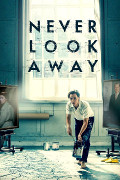
Directed by
Florian Henckel von Donnersmarck
189 minutes
Rated MA
Reviewed by
Bernard Hemingway

Never Look Away
Synopsis: The story of a boy growing up in Germany during WWII who becomes an art students and falls in love with a fellow student whose father harbours a dark secret that, unbeknownst to the young man, casts a long shadow over his life.
Florian Henckel von Donnersmarck's film is an ambitious, many faceted work that doesn’t quite come together as tightly as one might wish but which still deserves attention.
Never Look Away opens in 1937 with a recreation of the notorious Nazi Party exhibition of “degenerate” modern art that featured artists such as Picasso, Mondrian, Kandinsky, Paul Klee and George Grosz. We are introduced to a boy named Kurt (Cai Cohrs) and his young art-loving aunt Elisabeth (Saskia Rosendahl). We are also introduced to two of the main themes of the film, the social and moral function of art and the idea of “purity”, perhaps the most central of the Nazi shibboleths. This latter obsession is soon manifested with terrible consequences when after a routine psychological examination Elisabeth is forcibly removed to an institution for further evaluation, never to be seen by her family again.
So far Never Look Away appears to be yet another Holocaust film but it jumps forward in time to the 1950s and ‘60s. It’s quite a disorienting progression, one that gives us the conversion of East Germany into a Communist fiefdom and then, when Kurt escapes to the West, a kind of potted history of the artistic avant garde of the time including a prominent role for a Joseph Beuys-like art college professor.
The Nazi theme is woven through this material particularly in the person of the father of the fellow art student, Ellie (Paula Beer), with whom Kurt falls in love. This chillingly rationalist we know, although Kurt does not, was responsible for the fate of his aunt however the principal focus of the film is on how Kurt (now played by Tom Schilling), evolves into a successful artist (whose work looks very much like that of the real life German painter Gerhard Richter) effectively realizing his aunt’s spiritual gift to him (herself somewhat re-incarnated in the person of Ellie). Although audiences familiar with modern art history will probably realize that Never Look Away is in fact loosely based on the life of Richter (whose existential contribution is acknowledged in the end credits) for many people, myself included, the film may be a rather strange combination of fact and fiction.
Had writer-director von Donnersmarck framed his film to acknowledged its bio-pictorial origins I suspect that this would have helped, especially in justifying the lengthy sequence on post-painterly art which, amusingly disrespectful as it is, seems somewhat incongruous in a film which at 189 minutes could have taken some trimming. More importantly however dramatically the film, with the exception of the harrowing first section, lacks bite. Despite his quite traumatic life Tom Schilling’s Kurt is oddly blithe particularly in his, and for that matter his wife’s, relationship with his father-in-law, played with monstrous sang froid in the stand-out performance of the film by Sebastian Koch who starred in von Donnersmarck’s thematically-related 2006 Oscar winner, The Lives Of Others..
Somewhat questionable also are the film’s high-toned production values. Cinematography is by Caleb “The Right Stuff"’ Deschanel who was Oscar nominated for his work here whilst the two young lead actresses, both who have full frontal nude scenes, are rather improbably gorgeous. Also rather disconcerting is Kurt’s speed in knocking out paintings. A little less artistic license might have been judicious in portraying what is, after all, a serious matter. On the other hand, Max Richter’s resonant score is impactful and contributes significantly to the film’s dramatic efficacy.
Never Look Away covers a lot of territory, both temporally and thematically, and that is its strength. Audiences who will appreciate this richness probably won’t be unduly concerned that it doesn’t pull it all together into a neatly unified whole.

Want more about this film?


Want something different?




